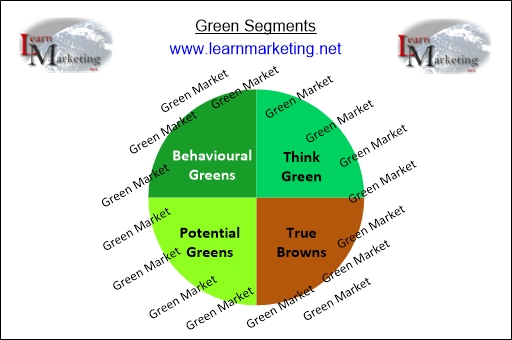Green Segmentation
Introduction
Once a firm has decided to enter Green Marketing one of the next steps is to carry out Green Segmentation. Green segmentation involves splitting the market based on a consumer's level of concern about environmental issues and the actions they take to deal with those concerns.
As consumers become more aware of green issues and adapt their buying patterns, a number of green consumer segments have emerged. Experian, a credit agency has identified four key green segments.
The diagram below spilts the market into four green segments as defined by the credit reference agency Experian.

Green Segments
Behavioural greens
This segments behaviour is totally geared towards being green. It is on the forefront of their mind when they shop, thinking and acting in a green manner. Their opinion is negative to organisation and products that cause a detrimental effect on the environment. They are most likely to pay a premium for green products.
Think Green
These consumers think about green issues, but do not always act upon the thoughts. They are highly educated and will buy green products if they have some form of practical value.
Potential Greens
This segment is young, below average income, and like to have the latest up to date products. They do not behave as green consumers nor is it on the forefront of their minds, however they can be swayed as they are young and their opinions are developing. They do believe that packaging should be recycled.
True Browns
This group have a complete opposite view then the above three groups. They are in fact against the green movement and believe it to be a waste of time, Their views are very negative. They are young, with high income and conservative in their thoughts, they are also impulse buyers.
LearnMarketing's Green Segmentation Groups
Learnmarketing has also identified a number of green segmentation groups that can be classified into certain groups.
Die Hard Greens
Care about the environment, usually have a family and teach their children the importance of their green principles. Encourage their children to recycle. Die hard greens are often well educated.
The Laissez-Faire Greens
Try to recycle where the opportunity arises but not overly concerned if they do not. Show concern about the environment, but think about the financial benefit first before the environmental benefit.
The Not So Green.
They do what makes their life and decisions easier. They do not like the complexity of being green and continue to follow old fashioned principles. The not so green are usually above the age of 40 and believe it is not their job to save the world.
Conclusion
Before a firm enters the world of green marketing they will need to decide what their motives are what segment of the market they would like to focus on. They will also have to examine their motives - is it to respond to consumer concerns about the environment? or is it to satisfy the firm's belief that their activities should sustain and not damage the environment. To learn more about Green Marketing visit our articles about environmental marketing.
Back to Green Marketing




